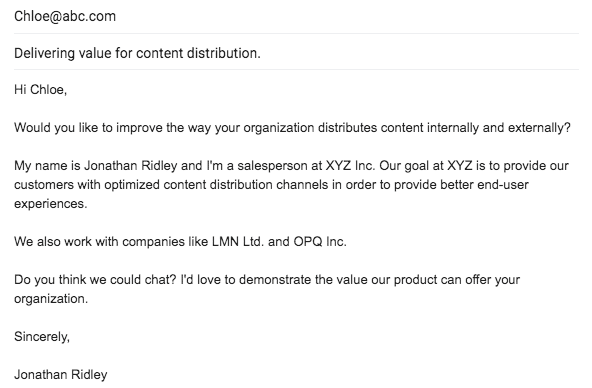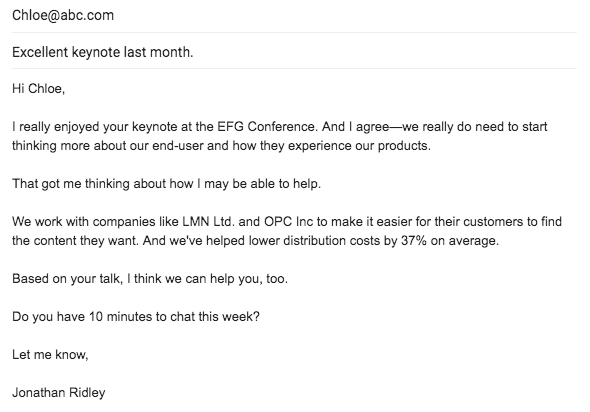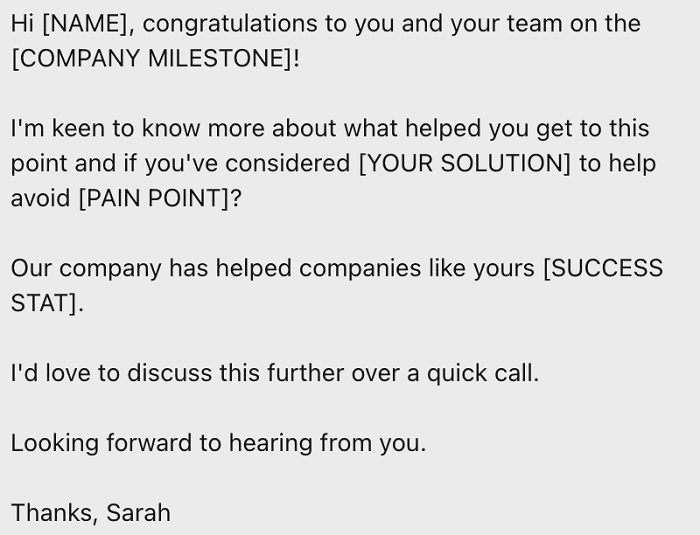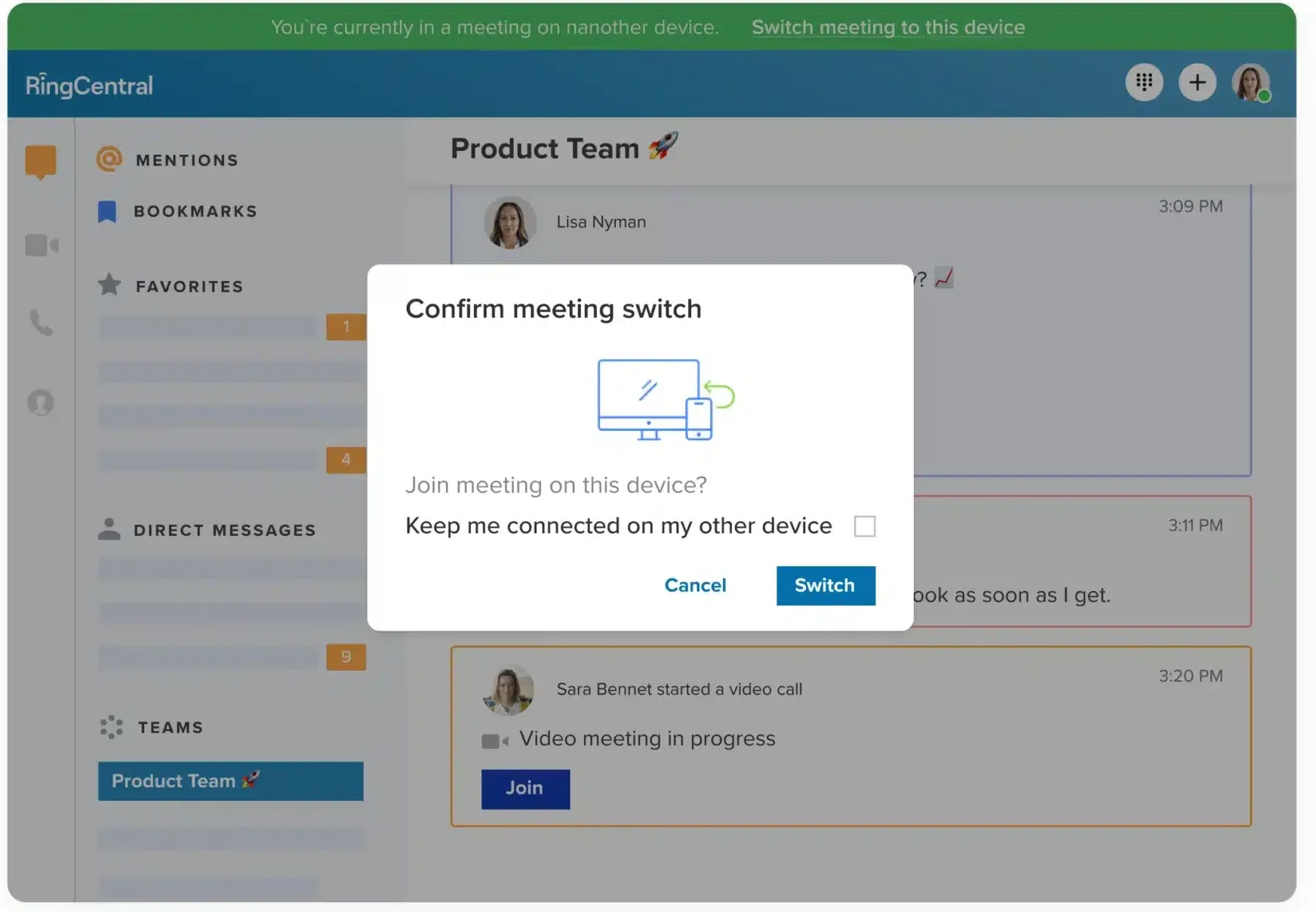Sales is one of the toughest roles in any company. Salespeople get rejected from prospects at a notoriously high rate, and if you’re managing SDRs who are responsible for making cold calls and cold emails, the job is even tougher.
But there are ways to succeed. According to LinkedIn, top-performing salespeople do more research—82% of top performers say they “always” perform research before reaching out to prospects (compared to just 49% for other sellers).
And when it comes to sales pitches, this becomes especially important. Not only do reps typically only get one shot at a pitch, it’s also the company’s only shot—if the prospect says, “No, thanks,” the company can’t just send another sales rep along to make another sales pitch in a week.
For a sales rep who’s pitching to a high-value prospect with a significant potential CLV (customer lifetime value) potential, making sure that sales pitch is as close to perfect as possible is crucial. That’s why it helps to learn from good (and not so good) sales pitch examples.
In this guide, we’re going to check out 11 of those examples (plus a few extras), and explore how to create a sales pitch that will leave prospects wanting to learn more instead of wanting to run away. We’re going to cover:
- What a sales pitch is
- 5 components of a successful sales pitch
- 11 sales pitch examples
- 6 tips to improve your pitches
🚀 Start closing more deals with this free outbound sales playbook.
What is a sales pitch?
A sales pitch is an attempt to persuade a prospective customer to buy a product or service. How does a sales pitch work? Generally, a good sales pitch identifies a problem or challenge the prospect has, acknowledges the issue, offers a solution through the product it’s selling, and supports it with proof. The pitch should make the value clear to the prospect.
Sales pitch vs sales presentation
While a sales pitch is tightly focused on persuading the prospect to take a certain action, sales presentations tend to be longer, more general messages that inform, educate (or even entertain) the prospect.
Presentations often include a “sales deck”, which is a visual element such as a slideshow in PowerPoint or Google Slides. This can also be used as a type of sales pitch.
What are the components a good sales pitch?
Sales pitches can take on various forms and use different approaches. But when you break them down, they almost always have these five key elements, and it’s important to get each one right so that your overall pitch succeeds. (It also helps to have good sales apps or cold-calling software and a Bluetooth headset if you’re going to be spending hours on calls.)
So, how to make a good sales pitch? Keep it short and clear, with a quick but friendly introduction, empathy with the prospect, a strong value proposition, supporting facts and social proof, and a strong close. By combining these elements, you can persuade the prospect that your product or service has the answer to their problems.
1. The open
The open is the introduction or opening line. It’s as simple as saying “Hello,” introducing yourself, and asking the prospect how they are. It’s also your first opportunity to start building rapport. If you start your sales pitch in the right way, you’ll capture the prospect’s attention.
Stay informed with RingCentral
2. Identification of the problem, pain point, and/or goal
By asking a few different probing questions about their work, you’ll start getting a better understanding of what the prospect’s challenges and goals are.
AI tools can be a huge help here. Some sales communications platforms with built-in AI can not only transcribe your sales calls, but also summarize important points, update your CRM’s notes automatically, and tell you what topics or questions prospects are bringing up most frequently. For example, RingSenseTM for Sales does exactly this:
3. Demonstration of value
Once you’ve established rapport and begun to understand the scope of the potential customer’s needs, you can begin to address each one using your product as the solution. You should be able to speak to one or more of their pain points with how your product can solve the problem.
Include a value statement, which is a clear and concise description of the value your product brings. This has to be outcome-focused, explaining the benefits rather than the features. Point out any unique differentiators that help your product stand out from its competitors.
4. Supporting facts
If you want to build trust, you should be prepared to support your pitch with facts and figures. Consider using social proof, like positive results that show how you beat customer expectations or prove that your other customers got something out of using your product or service.
For example:
- “Our customers save an average of 37% a year on their annual maintenance bills.”
- “Similarly sized businesses have seen a full return on their investment in only three months.”
5. The close
By now, you should’ve clearly shown your prospect the value of your product and how it’s going to make their job or life easier. The close is essentially the point where they say, “Yes,” and the transaction occurs. Be clear about the action you want them to take.
How to write a sales pitch to achieve optimal results
Now, let’s look at how to write an effective sales pitch. We’ve compiled a quick and easy guide to show you how to make a sales pitch that will refine your selling technique.
1. Have the right tools for the job
A phone system can’t pitch for you. But it can make pitching easier. Even better would be an AI-powered contact center platform that includes automation and integrates with your customer relationship management (CRM) tool. For example, this is what RingCentral’s looks like:
This will let you make sales calls from your computer, log scripts, see your past conversations with all your accounts, and keep track of conversations you’re having with both prospects and customers. Bottom line: you need some kind of communications tool.
Shameless plug: RingCentral has a whole range of integrations with different CRMs including Agile CRM and Salesforce:

🕹️ Get a hands-on look at how top-performing sales teams are using RingCentral by booking a product tour:
2. Use data to support your claims
Any salesperson can make a big, impressive claim. But the most persuasive salespeople are the ones who can back their claims up with real numbers and customer stories. One of the benefits of a sales pitch is that it gives you a golden opportunity to do this.
Where possible, use data to support the benefits of your product. Proof is the most powerful tool in your sales arsenal. As well as customer success statistics, share industry recognition and awards. This will all help prospects to see you as a company that walks the talk.
3. Do your research
Gone are the days of picking up a phonebook and dialing prospects without knowing anything about them. Today, to even get a chance to pitch, you need to do your research first.
Use LinkedIn to learn more about your prospect. Know their company. Understand what they do. Look at the kind of content they’re posting. It can provide you with enough information to start a conversation worth having.
4. Plan your pitch
Once you’ve got a list of people you’re going to reach out to and you’ve done the research, it’s time for sales call planning. You’re going to be delivering a similar pitch to each one, but you’ll need to keep it flexible to adapt to their individual needs.
It’s important to plan what you’re going to say—this doesn’t mean literally reading out a script as you’ll sound like a robot, but you should have a template in front of you to act as a guide and make sure you’re never lost for words.
5. Use a conversation starter
How to start a sales pitch? Jumping right into a pitch probably won’t get you very far. Be friendly and build rapport with your prospect first to move from a “hello” efficiently into your pitch—without sounding too sales-y or coming on too strong.
6. Practice
You have to know your pitch to nail it. So put aside some time to really practice it. Try it out on coworkers. Run through it at home with your spouse. Sit in front of a mirror and pitch to yourself. Have a rebuttal for every objection. Knowing your product and your pitch inside and out is the key to being able to sell with confidence.
7. Talk about benefits, not features
This is the first rule in the book for improving your sales pitch. Your product may have the best features in the world. But they don’t amount to much if they don’t solve your prospect’s problem. Focus on how the benefits of those features address prospects’ problems or pain points—and how they can help them reach their goals.
How to pitch a product
You might be wondering how a product pitch is any different to a sales pitch. Well, pitching a product means you’re 100% focused on a single product or service, whereas a sales pitch can have a broader scope in some scenarios. This will depend on the type of company you represent and the prospects you’re talking to.
For example, let’s say you work for RingCentral, which offers a wide range of products. If you’re contacting the prospect for the first time, you might want to keep things a little more general until you figure out whether they’re in the market for unified communications, a contact center solution, or standalone video conferencing.
But if you’re specifically targeting them with one of those products, you can use a more focused product pitch. You can go in-depth on the details, telling the prospect how these particular features would benefit them.
11 Sales pitch examples
There are countless ways you can pitch to a prospect. But you want to use the right kind of pitch at the right time and for the right customer. Below are 11 different ways to pitch, including a sales pitch example for each, why it works, and, for some examples, tips on when you shouldn’t use them.
Once you see exactly what good sales pitch examples involve, you’ll know exactly what to aim for to have the best chance at success.
1. The phone pitch
Believe it or not, the phone call is still the most popular and effective selling channel and with good reason: it’s fast, easy, happens in real time—and is much harder for your prospect to ignore.
One of the best sales pitch examples is when billionaire Mark Cuban purchased the Dallas Mavericks in the early 2000s. He bought the team at a discount because, frankly, they stank. They were rated the worst professional sports franchise of the ‘90s. Naturally, this led to low ticket sales.
So Mark got on the phone and started calling past season-ticket holders. And guess what? It worked.
Watch Mark Cuban tell the story about his best phone sales pitch in his own words.
Why did it work?
- He was friendly and built rapport with his prospects.
- He demonstrated value. (A game is less expensive than a meal at McDonald’s. Wowza.)
- He understood that he wasn’t selling a bad team—he was selling a memorable experience.
If you’re on a call with a prospect and hoping to have the same level of success as Mark Cuban, you may feel your pitch could benefit from showing the prospect some visuals on your screen. How could you do that?
It’s pretty straightforward. There are tools (like RingCentral) that let you flip between a phone call and video call so that you can do screen sharing if that’s where the conversation takes you:
2. The email pitch
Done well, a good email sales pitch is probably the best tactic a rep has at their disposal. In fact, C-level executives are 23% more likely to answer cold B2B emails than employees outside the C-suite.
But to be successful at email sales pitches, your sales email subject lines have to be click-worthy.
Emails are a great way to introduce yourself and your company while demonstrating the value in what you’re selling. But it’s also easy to do poorly. For example, here is the wrong way to pitch via email:

Why this doesn’t work
- The email starts with a hyper-specific question that feels like it’s providing a solution to a problem no one has.
- The value proposition is poorly expressed. What is an optimized content-distribution channel? What are end-user experiences?
- The mention of other customers feels more like name-dropping than a good use of social proof. (There’s a better way to do this—see example below.)
- There’s no clear value demonstrated, so it’s very unlikely that Chloe will respond.
Here’s a better example from the same person at the same fictional company:

Why this works:
- The pitch starts with a shared experience. In this case, a conference—but it can be any commonality.
- Value is demonstrated clearly and immediately. There’s no ambiguity about what they’re selling and how it helps.
- Social proof is added tactfully.
- Benefits are supported by data.
- The salesperson doesn’t come on too strong.
3. The voicemail pitch
If you work in sales, you’re going to hit a lot of voicemail inboxes. And that’s okay, because successful deals often start with up to eight attempts to actually speak with your prospect.
So while hitting an inbox can feel like a miss, don’t be discouraged. It’s actually an opportunity to make a great first impression and plant a seed before your next attempt.
Example:
Hi [Prospect’s name],
This is [your name] calling from XYZ company. Sorry I missed you.
I was hoping to speak to you about [reason you’re calling]. We’ve helped other companies [insert benefit], and I think we may be able to help you get similar results.
You can reach me at [insert phone number] if you’d like to learn more. But I’ll follow up soon.
Why this works:
- It’s personalized and friendly.
- It doesn’t beat around the bush—the value prop is upfront and center.
- It supports the value prop with previous results.
- It’s short, which is important because otherwise there’s a very good chance the prospect won’t listen to the whole thing.
- It promises to follow up, which will not only make them expect to be contacted again but it will also mean that they’re more receptive to that.
And if you say you’re going to follow up within a certain time frame, do it!
The vast majority of deals don’t close in one go, and you have to be both persistent and organized in how you plan your follow-ups. If you know you have a lot of prospects to follow up with, create tasks for yourself (and your team).
For example, RingCentral’s desktop and mobile app allows you to not only create team chats for different projects or departments but you can also assign tasks with due dates, relevant files, and even color-coding for easy organization:
4. The deck pitch
If you’re invited to make a pitch, congratulations. It means you’ve got a foot in the door, you’re in front of a receptive audience, and half the work is already done. (Although there’s a good chance you did that work. So good job there, too.)
Of all the sales pitches examples, for this type, it’s crucial that you get your face-to-face communication spot on. And we’re not just talking about being able to rattle off the sales pitch script that you learned by heart. Your body language plays a big part in it too.
A pitch deck is basically a sales pitch in a presentation format—PowerPoint, Google Slides, or whichever presentation platform you use. This type of pitch makes it easy to tell a story and highlight key points using visual aids that can be very persuasive.
For example, check out this successful pitch deck from restaurant technology startup Lunchbox, which it used to raise $50M from investors. (Fundraising is a type of sales too!)
Why it works:
- It clearly explains how the solution resolves a pain point.
- It includes a real-world example of a customer helped by the solution.
- It uses data to back up its claims.
- The presentation design is clear, simple, and vibrant.
5. The elevator pitch
This type of pitch gets its name from the idea that you should be able to say it in the span of an elevator ride. A good elevator pitch explains what your product does in an extremely concise and effective way.
Take this often-cited example from G2 Crowd.
Why it works:
- Instead of repeating the product’s value proposition verbatim, the rep explains what the product does and why it’s useful in words that everyone can understand.
- It’s 21 seconds long—about half an elevator ride in New York City.
6. The follow-up pitch
It’s hard to close a customer on first contact. (Remember, it takes up to eight tries just to get a meeting.) So, focus on getting a shot at a second or third meeting where you’ll have a better understanding of each other and a better chance at closing the deal.
The key to a good follow-up pitch is to make it timely and relevant without being a bother. A good way to do this is to mention a past point of contact or conversation (if you’ve had one).
For example:
“Hi [their name,]
It’s [your name] from [your company]. Last time we spoke, you mentioned [problem that the prospect experienced]. I’ve given it some thought, and I think I know how I might be able to help you [insert the benefit of your product, as it relates to their problem].”
From there, you can move the conversation forward. Or in the case of an email or voicemail, mention that you’ll follow up again and suggest a time to chat.
Why it works:
- The pitch refreshes their memory and provides context for the conversation.
- It highlights the problem they experienced and how you can solve it.
- It’s appropriate in any scenario—phone call, email, voicemail, or social message.
7. The social media pitch
Social selling is all the rage, but it’s challenging to grab prospects’ attention amid the daily avalanche of posts and tweets. You can do this by creating your own eye-catching content, but you can also use it as a form of outreach to make connections with individual prospects.
For example, if someone’s talking about a problem on X/Twitter and it’s a problem your product can solve, then take the opportunity to start a conversation. Or, if you notice a LinkedIn post from someone in your industry, send them a mini-pitch via direct message.
Here’s an example:

Why it works:
- It’s short and to the point.
- It contains a conversation starter that shows the rep has done some research.
- It mentions the product, references a pain point, and includes a stat.
8. Video sales letter
This one is basically a sales pitch in the form of a video. Rather than just using words to explain why your product is awesome, you have the opportunity to engage the prospect with a visual explanation.
Throw in some music, graphics, even animation if you want to—it all helps to make you more memorable.
You might send it directly to a prospect to introduce the company or provide extra information after a call. Or you might post it on your website or social media. Either way, people tend to process visual information faster and retain it for longer.
Here’s a B2B example from Semrush:
Why it works:
- It’s colorful, vibrant, and immediately captures the attention.
- It shows exactly how the product works and how it solves a problem.
- It has a compelling CTA at the end.
9. Website sales pitch
A website sales pitch is a message that you display—yes, you guessed it—on your website (or landing page). You’ll position this content strategically to attract maximum attention when prospects visit on a fact-finding mission.
This type of pitch typically involves storytelling, descriptions of your product or service, and sometimes customer testimonials. The aim is to encourage the visitor to take a specific action, so make sure there’s a CTA at the end.

Why it works:
- It stands out with its unusual monochrome design
- It manages to target two specific customer segments (baristas and non-baristas) but makes the product seem inclusive to both
- It has an informal style to appeal to a young, trendy audience
- It uses graphic elements (such as logos) to add nutritional and sustainability info while keeping the word count low.
10. Two-sentence pitch
Sometimes called the 12-second pitch, this is best used when time is short—for example, when a prospect is super-busy, or you need some compelling copy for a social media post or a landing page.
It’s useful as a conversation-starter with investors, or you could use it as the intro for a longer pitch.
Here’s how it goes:
Sentence #1: Brief but comprehensive summary of what you do
Sentence #2: What makes you different from your competitors.
Check out this business pitch example:

Why it works:
- It totally nails the whole “keep it short and sweet” brief.
- However, it still sums up the key message that a prospect needs to know—i.e. what the product is, what it does, how it benefits them, and why it’s better than the rest.
11. Live sales pitch
There might be times when you need to deliver your sales pitch in person. For instance, if your company has a stand at an industry or networking event, or if you decide to embrace the world of TV shopping channels. Sounds daunting, but it gives you the chance to interact with a live target audience—and to give a demonstration of your product.
These pitches have to be highly engaging and entertaining, like this classic from Shark Tank when Aaron Krause introduced the world to the Scrub Daddy cleaning tool.

Why it works:
- There’s a brief summary, including a unique selling point about the product
- Then it’s straight into the demo, showing the product in action
- The presentation style is slick and entertaining—as Daymond John says, it’s like a live infomercial.
Sales pitch presentation examples
As we mentioned earlier, sales presentations are typically longer than traditional sales pitches and often involve slideshows (deck pitches) or videos.
However, you can absolutely use a concise presentation as your sales pitch if the situation lends itself to this approach. Let’s take a look at a few examples:
Algoplanner explainer video

This video for Algoplanner’s supply chain SaaS product pairs animated graphics with a narrative-style voiceover, telling potential customers what might happen if their system fails to cope with high volume.
Why it works:
- The look is clean and minimalist, with cute graphics adding a fun touch
- It uses storytelling to guide viewers to a conclusion (i.e., they need good supply chain software)
- It clearly positions Algoplanner as the ideal solution and includes a CTA.
Leadnomics deck pitch

Freelancer Katya Kovalenko designed this presentation for online marketing company Leadnomics, who also include elements of it on their website and use it as a brand template. It’s a classic deck pitch of individual slides providing key information about what the company does for its clients.
Why it works:
- The very simple design and color scheme lets the info stand out and speak for itself
- Stats are presented visually, making them easy to understand at a glance
- It includes social proof, by listing companies that use Leadnomics
- It ends with a clear call to action and contact details.
RingCentral explainer video
Not to toot our own horn, but we’re proud of this one. It’s kind of a cross between a deck pitch and a video sales letter. It uses graphics instead of spoken dialog to guide viewers through the key benefits of the RingCX platform, with a particular focus on the AI tools and how they can help contact center managers and reps to provide better customer experiences.
Why it works:
- It has a clear brand identity and very simple messaging
- It focuses on the benefits rather than the features themselves
- It neatly encapsulates the tool’s USPs in a short time frame.
Sales pitch templates
We’ve already included a couple of templates in the earlier sales pitch examples section, but here are three more for three different scenarios. You can tailor each one to your own situation.
Phone sales pitch
This template could be used for a cold call, once you’ve done a little research onto the prospect:
Hi [prospect name], it’s [your name] from [company]. Hope you’re having a good week so far! Do you have a few moments to chat about [product/service]?
If they say no: Okay, no problem. Would you prefer me to call again at a better time for you, or can I send you an email instead? [arrange a time/get their email address]
If they say yes: Great! I see that you’re in [industry]. We’re currently working with several companies in [industry] and a lot of them have mentioned [challenge/pain point].
[Add relevant statistic/customer success story and ask them about their own challenges]
Well, that’s definitely something we can help with. [Tell them the key benefits of your solution, in relation to their pain points. Answer any questions]
How about I send you our whitepaper with the full product details? [check their email address]. And let’s set up another call for next week, when you’ve had time to read through it. Is [date/time] good for you?
If they agree: Thanks for your time today. Have a great week/weekend!
Social sales pitch
As we mentioned, you can use a direct message (DM) on social media platforms such as X/Twitter if you see that a potential lead has someone posted something relevant. DMs give you more characters to work with than posting a public reply, but you should still keep it short and sweet:
Hi [prospect name],
Hope you don’t mind the DM. I just saw your tweet about [topic], and I have the solution: [product name] can help you with [problem] by [brief explanation of benefits].
If you want to learn more, DM me back to set up a call, or check out our website: [link]
Many thanks,
[name]
Social proof email
It’s always a good idea to provide social proof to your prospects, from dropping the names of big companies you’ve worked with to telling stories about existing customers.
This template could be used as a follow-up after you’ve had an initial interaction with the prospect, and you want to give them some more food for thought:
Hi [prospect name],
Thanks for your time earlier today. It was great to talk to you and find out more about your company and your challenges. As promised, I’m attaching some more case studies that show how [product] has helped other customers.
Example 1
Example 2
Example 3
Looking forward to chatting again in our scheduled call next Tuesday – but if you have any questions in the meantime, don’t hesitate to drop me a message.
Kind regards,
[name]
What a great sales pitch comes down to…
Most prospects today are seasoned buyers. They know when they’re being pressured into a sale, and even if you do manage to close the deal, starting a business relationship on a sour note won’t be helpful in retaining that customer down the line.
When doing your sales pitch, keep that long-term customer relationship in mind.
There are various ways that you can pitch a prospect, but the most important thing you can do is demonstrate value. Learn what the prospect is struggling with, empathize with them, understand their pain points, and find a way to help them overcome the problem that stands in their way.
By doing that, your prospects will see you as a valued and trusted partner rather than a vendor. And that’s going to make it easier for you to pitch—and close more deals.
Updated Jul 16, 2025














